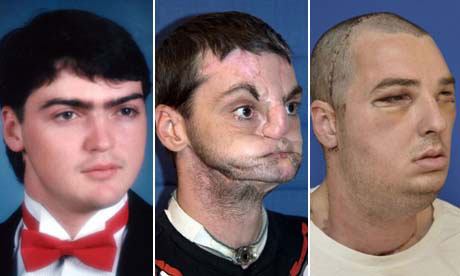Internet Debris

NOTHING posted here is mine!
Internet Debris does not claim rights to any
photos or media content posted to the site.
First human head transplant now possible neurosurgeon claims
The first ever human head transplant is now possible, a neurosurgeon has claimed.
Dr Sergio Canavero believes that the technology now exists that will allow surgeons to carry out the Frankenstein-style procedure, which has been tested out on animals since 1970.
Up until now there has been no way to successfully reconnect the spinal cord, leaving the subjects paralysed from the point where the transplant was connected.
Recent advances have meant that re-connecting the spinal cord is now possible, and it is believed that the breakthrough means that previously fatal diseases could be cured.
However, other experts have dismissed the idea.
Professor Anthony Warrens, from the British Transplantation Society, toldthe Sun: "Connecting a head to a body is worthless to human beings today. The whole concept is bizarre."
In 1970, Robert White successfully transplanted the head of a rhesus monkey onto the body of a second rhesus, and Dr Canavero, a member of the Turin Advanced Neuromodulation Group, has proposed using a similar method.
He said: “The greatest technical hurdle to such endeavour is of course the reconnection of the donor's and recipient's spinal cords. It is my contention that the technology only now exists for such linkage,” he wrote.
“It is argued that several up to now hopeless medical conditions might benefit from such procedure.”
He believes that it a team of 100 could perform the operation in 36 hours — at a cost of £8.5million.
Both heads would have to be removed at the same time, and reconnected within an hour.
"This is no longer science fiction. This could be done today — now. If this operation is done it will provide a few people with a substantial amount of extra life,” he said. “The only reason I have not gone further is funding."
However, Dr Calum Mackellar, from the Scottish Council on Human Bioethics, added: "This sounds like something from a horror movie."
Face transplant man doing well after biggest operation yet

Richard Norris as he was in 1993 (left), in a pre-transplant, photo,
and as he looked on Monday, March 26, 2012. Photograph: Reuters
After 15 years of wearing a mask and living as a recluse, a 37-year-old Virginia man disfigured in a gun accident has been given a new face, nose, teeth and jaw in what his doctors say is the most extensive face transplant yet performed.
Richard Lee Norris, of Hillsville, is recovering well after last week's surgery, beginning to feel his face, and already brushing his teeth and shaving, University of Maryland medical centre officials said. He has also regained his sense of smell, which he lost after the accident.
Norris, who was selected for the surgery from among five possible candidates, has been living as a recluse, doing his shopping at night. Dr Eduardo Rodriguez, the lead surgeon, said he hoped the transplant would give Norris his life back.
"It's a surreal experience to look at him," he said. "It's hard not to stare. Before, people used to stare at Richard because he wore a mask, and they wanted to see the deformity; now they have another reason to stare at him, and it's really amazing."
Rodriguez showed a 1993 prom photo of Norris – "as we all want to be remembered" – beside a pre-transplant photo of Norris' shortened face, with a sunken mouth and flattened nose. He then produced a photo of Norris taken on Monday, in which his face appears ordinary, apart from some stitches along his hairline and neck and scarring around his eyelids. Although he had the donor's face, he did not resemble the donor, Rodriguez said: "It's a combination of two individuals, a true blend."
Norris's vision was largely unaffected by the accident. Because of numerous reconstructive procedures, his forehead and neck were mostly scar tissue. Norris had no teeth, no nose and only part of his tongue. He was still able to taste but could not smell.
"He could not smell for the past 15 years, and that was the most dramatic thing: immediately, on day three, he could finally smell," Rodriguez said.
Doctors gave few details about the donor, citing the family's desire for privacy. They said the donor's organs had gone to several people. However, the donor's family had been consulted specifically about donating the face, said Charles Alexander, president of the Living Legacy Foundation. He said consenting to be an organ donor did not automatically extend to face donations.
The 36-hour operation was the most extensive of its kind because it included transplantation of the teeth, upper and lower jaw, a portion of the tongue and all facial tissue from the scalp to the base of the neck, Rodriguez said. Because it included so much facial tissue, the incisions were further back and were less visible.
The most dramatic moment came when the team had finished removing all the previous attempts at reconstruction. All Norris had left was a part of his tongue and minimal protection for his eyes. Rodriguez called this the point of no return.
"At that point, we had to be successful," he said. Norris would require minor revisions, but those would be outpatient procedures, he added.
The face transplant was the 23rd since doctors began doing the procedure, seven years ago. The first full face transplant was performed in France in 2005 on a woman who had been mauled by her dog.
The US defence department has been funding some face and hand operations, with the goal of helping wounded soldiers. More than 1,000 troops have lost an arm or leg in Afghanistan or Iraq, and the government estimates that 200 troops may be eligible for face transplants. The University of Maryland's research on transplants was funded by a grant from the Office of Naval Research, and doctors said they hoped to begin operating soon on military patients.
Dr Rolf Barth, a transplant surgeon, said researchers had found there were fewer rejections with transplants involving a large amount of bone marrow with its own blood supply. Norris would have to take immunosuppression drugs for the rest of his life, to keep his body from rejecting the donated face. "This was the perfect patient to put into practice what we had discovered in the laboratory," Barth said.
Officials provided little detail on Norris or the circumstances of the accident that destroyed most of his face. He graduated from high school in his small, south-west Virginia hometown in 1993, and was employed at the time of the accident. Since then, he has lived with his parents and has not had a full-time job, according to Rodriguez.
"This accidental injury just destroyed everything. The rest of his friends and colleagues went on to start getting married, having children, owning homes," Rodriguez said. "He wants to make up for all of that."


If you like what you see here
- tell your friends!







No comments:
Post a Comment